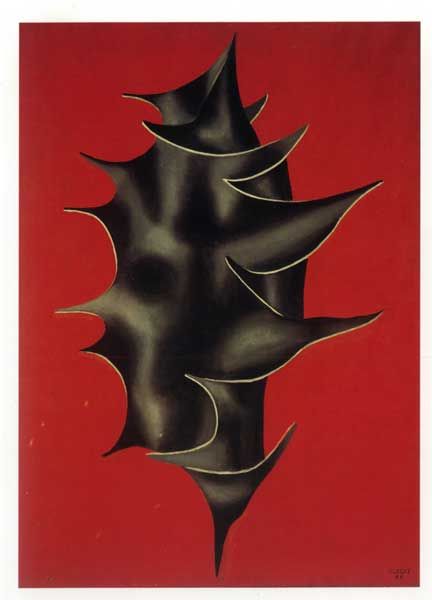Great Works: Holly Leaf on Red Background (1928), Fernand Léger
Private Collection, Paris

The holly bears the crown, as the old carol sings. It bears a blossom as white as lily flower. It bears a berry as red as any blood. It bears a prickle as sharp as any thorn. It bears a bark as bitter as any gall. And the carol goes on to explain that these various aspects of the holly each stand for an aspect of sweet Jesus Christ's life and mission.
For Christians, and before them for Celts and Romans, holly has been a sacred and symbolic tree, especially associated with this season; Saturnalia, Christmas. That Christmas carol shows just how meaningful the plant can be, or can be made. It positively sprouts with allegories. On the other hand, turn to Fernand Léger's Holly Leaf on Red Background.
Léger's realisation of the holly goes quite the opposite way. It is secular. It is literal. If at this time of year holly becomes a richly articulate plant – for the godless too it is a cheering, evergreen sign of life in winter – Léger's holly is strictly dumb. You might say that in his picture it becomes a purely natural thing, but even that would be an exaggeration.
This holly leaf might have been part of a festive still-life; it might have been part of a thriving woodland scene. It's neither. This single leaf is extracted from all surroundings or roots. It lacks any suggestion of life context or life source. It lies isolated on a plain background. It's not a growing organism. It's presented like a cut-out botanical specimen.
The emphasis in this image is on the holly's substance – on its conspicuously unvegetable substance. Holly is anyway far from being a succulent plant. Its surface is sharp and shiny. It is easy enough to see it as being made of plastic. Léger takes this further. He brings out holly's hard, metallic quality.
You see this in its edges and its spikes. They look like a piece of sheet metal that's been cut into curves, and bent and twisted. These edges are themselves cutting edges. These spikes could pierce flesh. It's a stuff that makes you think of a can and a can opener. The holly's evergreen flesh is given the permanence of metal. (Its spikiness is upped by the two spikes that are on the point of touching the top and bottom edges of the picture.)
You see it in the leaf's colour too – or rather in its de-colouration. The holly's green is turned into black and white. This has a biological implication. Drained of green is drained of chlorophyll. The leaf is specifically dead. Admittedly, the deep-red background has a counter optical-effect. Through complementary contrast, this red introduces a hint of green into the monochrome leaf. But it's only a mild hint.
The main effect is to say the opposite: that unlike the background, the leaf is utterly without hue. The background is filled uniformly with the most primary of primaries, a saturated red. The leaf has only tone and form. Our attention is all on its light and shade and shaping.
And the leaf's shaping is especially stressed because it is so peculiar – extremely complex and perhaps impossible. This holly leaf is made out of curves and spikes and waves just like a normal holly leaf. But the way these forms are assembled is another matter.
For example, try to follow its formations, its bumps and hollows, as indicated by the shadings and highlights, across its surface. It's like an area of corrugated iron, dented and folded. Now compare this landscape with the landscape implied by the outside edge on the left side. Can the two be co-ordinated?
And then try to visualise the forms that are suggested by the edges on the right side, as they zigzag in and out, as their spikes fold in and out. It is nearly impossible to translate this holly image into a curling form in three-dimensional space. It exists only as an image.
The punch line, the grace note, is that small tusk that emerges from behind the leaf, top right. How, where could it be attached to the leaf? Nowhere. Yet in terms of pure design it couldn't be more strongly attached; it picks up neatly on to a curve that passes "through" the leaf and into a spike that appears the other side.
There is no religious symbolism, here. There is no nature sentiment. There is simply physical presence. The holly leaf provides Léger with an object for variation, for pattern, for intensification. (His first move was to strip off its berries.) He intensifies it by making it dangerously sharp. He intensifies it by making it spatially baffling. He intensifies it with a surround of blazing red. The holly bears the crown.
About the artist
Fernand Léger (1881-1955) is the most embracing of modern painters. He refuses to be alienated or agonised. He pursued an open, public, monumental and democratic art that would manifest the new forms and promises of 20th-century industrial life. He was at first an outrider to Cubism; his version, with its stress on cylinders, is sometimes called Tubism. After fighting in the First World War, and apparently immune to nightmare visions, whether of war or industry, he evolved a vocabulary of half-abstract machine-shapes and semi-robotic humans. His 1924 film 'Ballet mécanique' was a celebration of repetitive forms and rhythms, a manifesto of new impersonal beauty. Later, Léger developed a more humanist repertoire of heavy-but-buoyant figures, working and playing together, with a sequence of builders on girders; safe, graceful, optimistic, but tough, and never simply jolly.
Subscribe to Independent Premium to bookmark this article
Want to bookmark your favourite articles and stories to read or reference later? Start your Independent Premium subscription today.

Join our commenting forum
Join thought-provoking conversations, follow other Independent readers and see their replies